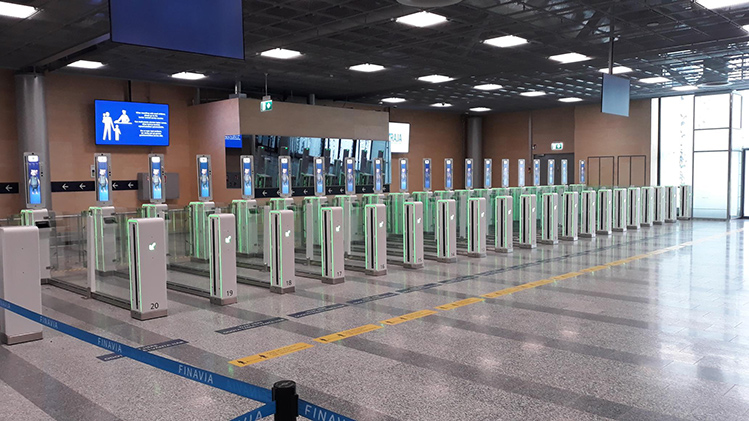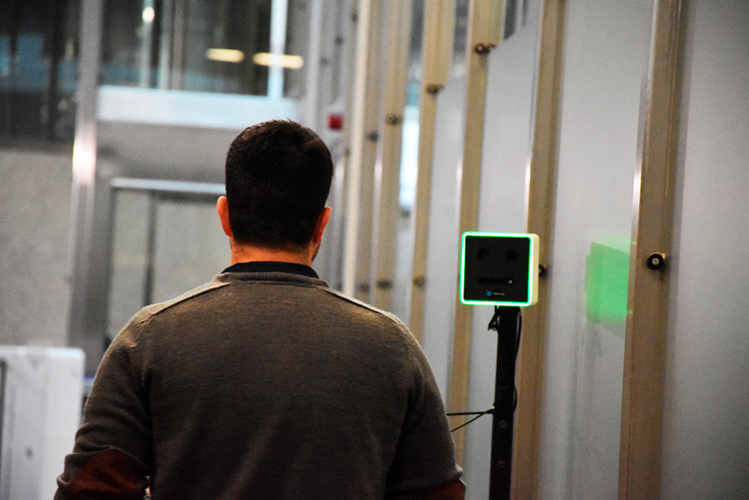An interview with Jeff Lennon, Head of Strategic Sales & Global Partnerships, Vision-Box. By Ross Falconer
Introduction of the Schengen Entry-Exit System (EES) in 2022 is predicted to be the next frontier of border control, as 26 European countries embrace state-of-the-art smart technologies and improved operational means to protect national borders.
“While many people may mistakenly think innovative technology will replace human operated tasks, the successful implementation of EU Smart Borders actually involves ground-breaking technologies to support Border Control Officers and make their mission more effective and enjoyable,” explains Jeff Lennon, Head of Strategic Sales & Global Partnerships, Vision-Box.
The implementation of self-service systems and automated border controls will streamline the movement of passengers by providing Border Guards with enriched travel information, interoperability between Member States and central EU platforms, and accelerated processing capabilities for labour-intensive tasks.
“Automating highly repetitive tasks, such as document authentication, identity verification and cross-referencing watchlists, frees-up officers to focus on the psychological and behavioural assessments they’re specifically trained to undertake,” says Lennon. “Whether it’s analysing a passenger’s body language, identifying someone who seems unusually nervous, or noticing contradictions in their speech, human-centric risk-based assessment is the final line of defence for all border crossings.”
Additionally, the EES aims to use digital stamps, facial image recognition, and biometric data collection to create a real-time validation of travellers’ movements and identity. Instead of relying on Member States’ border control agencies to physically stamp travel documents, digital time and location stamps will be stored in a shared, central EU-wide database, relieving Border Control Officers from interpreting information from non-standardised stamps.
“The EU Smart Borders package sets the stage for a new wave of technological innovations in the travel industry,” Lennon comments. “While technology can increase efficiency, reliability and security for managing the flow of travellers, EU Member States also need to think about the practical challenges of implementing new processes, adopting new technologies, and overcoming the complexity of integrating machine-operated systems into national security measures.”

Jeff Lennon, Head of Strategic Sales & Global Partnerships, Vision-Box: “Vision-Box is committed to providing out-of-the-box innovations to push technical boundaries and deliver future-proof solutions to long-standing problems. We pride ourselves on executing seamless experiences for the connected traveller and guaranteeing reliability and scalability across our suite of technologies.”
“Seamless experiences for the connected traveller”
Despite the challenges of implementing Europe-wide initiatives and standardising highly-technical processes across multiple stakeholders, the opportunity to build a truly connected, orchestrated and intelligent ‘new frontier’ to protect our borders is unprecedented.
“Vision-Box is committed to providing out-of-the-box innovations to push technical boundaries and deliver future-proof solutions to long-standing problems,” Lennon explains. “We pride ourselves on executing seamless experiences for the connected traveller and guaranteeing reliability and scalability across our suite of technologies.”
The seamless traveller experience may start from their home, where travellers can perform an EES pre-registration using their mobile phone. During this step, Third Country Nationals are requested to provide their biographic information, as well as to reply to a set of questions, normally performed at physical borders.
Upon arrival at a Schengen border, the pre-registered individuals are requested to use a kiosk to complete the remaining steps, in compliance with the Entry-Exit System regulation. “In line with the COVID-19 pandemic, and to enhance travellers’ comfort and increase sanitization, Vision-Box has evolved its existing Seamless portfolio that enables travellers to interact with the kiosks by using their smartphones in a completely touchless way,” says Lennon.
Once the registration is completed, eligible travellers may be invited to officially cross the border, either using an On-The-Move Automated Border Control eGate, or a Smart manual booth, only presenting their face to reconcile their border-crossing profile. “This unique approach accelerates the whole process and provides a complete touchless and seamless walk-through, enabling a quick and safe border crossing process,” Lennon explains. “This is exactly what we are currently implementing at Helsinki Airport in phases, with our long-time partner, The Finnish Border Guards, through a prime contract we were awarded in early 2019. It is the first official EES deployment in Europe at an airport, paving the way for other Member States and airports to avoid reinventing the wheel.”
Vision-Box aims to support EU Member States in complying with the Entry-Exit System regulations. “Our Border Control portfolio includes a set of touchpoints, combining state-of-the-art technology with our Orchestra™ Software suite to ensure strict compliance with both the Entry-Exit System regulations and GDPR,” says Lennon.
Key solution features relevant to the new Entry-Exit System requirements include: hardware and software elements that enable the GDPR-compliant capture and exchange of personal information, automatic camera height-adjustment and smart illumination compensation for capturing high-quality facial biometrics, and user-centric customer experience design that optimises passenger processing efficiency.
“We pride ourselves in offering a truly unique value-add through a proven delivery capability, leveraging proven innovative technology, sustained by robust processes and organisational change-management support, all from a single one-stop-shop,” Lennon emphasises. “In addition, we have unparalleled real-world experience in border control with over 6,000 solutions delivered to date, and best practices and lessons learned from previous projects in Europe.”

Vision-Box aims to support EU Member States in complying with the Entry-Exit System regulations. “Our Border Control portfolio includes a set of touchpoints, combining state-of-the-art technology with our Orchestra™ Software suite to ensure strict compliance with both the Entry-Exit System regulations and GDPR,” says Jeff Lennon, Head of Strategic Sales & Global Partnerships, Vision-Box.
“Complete contactless border crossing”
COVID-19 has profoundly impacted the travel industry, with contactless processes evolving from being a desired concept to a very much needed reality. Borders are no exception, and the right balance needs to be achieved between security and contactless, hygienic facilitation.
“Touchless screen control technology, such as enabling the utilisation of mobile phones as a remote control, will reduce the need for touching surfaces, relieving operators from guaranteeing a more recurrent disinfection of the touchpoints,” says Lennon. “Unleashing the power of facial recognition as the primary biometric modality for touchless data validation and border crossing enables the reduction of traveller contact with eGates or manual counters. Arrival passengers who pre-registered at a kiosk can directly go to the next step, where no additional action is required except validating their face image against the initial kiosk record. This approach will ensure a complete contactless border crossing, while guaranteeing high-level standards of security.”
As with any technological innovation, implementing cutting-edge smart borders solutions doesn’t come without its challenges. While EES and ETIAS (European Travel Information and Authorisation System) also express the EU Commission’s desire to embrace new technologies to achieve real-time interoperability in the digital control of Schengen entries and exit, Lennon believes we’re yet to scrape the surface of how technology could shape the future of EU border controls. “To ensure a smooth and seamless passenger flow, industry leaders must deliver user-friendly solutions that are easy to understand across a range of ages, nationalities, and languages,” he says.
Crucially, Vision-Box’s global coverage across more than 80 international airports down to its growing presence across 13 European States generate a culturally diverse repository of training data to help the community building highly-representative Artificial Intelligence (AI) models.
Lennon explains that, as the technology advances, Vision-Box is committed to combating challenges associated with unconscious machine bias and delivering systems that are sensitive to a range of nationalities, races, genders, and ages. “A large and diverse dataset gives way to fair and representative modelling. Additionally, innovators in this space must explore the best way to inform passengers about what to expect before using Automated Border Control systems, and offer clear guidance while using them, to ensure a smooth and painless process from start to finish.”







